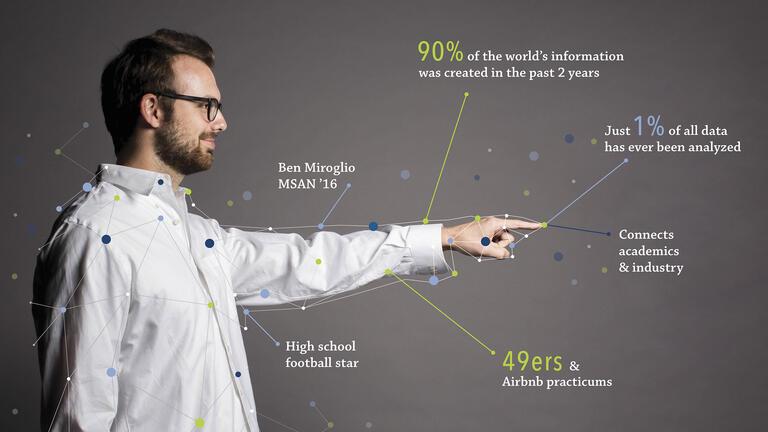

Big Data
Could your data change the world?
Whether you realize it or not, it’s already transforming your daily life. Corporations use big data to predict your next online purchase, health care providers to prevent the spread of disease, schools to assess how your children learn, and credit card companies to block fraud.
So what is big data? It’s information gathered from online clicks, airport arrivals and departures, weather reports, millions of medical records, and much more. It’s so voluminous and complex that traditional data processing is inadequate. It requires tens, hundreds, and even thousands of networked computer servers to store, handle, and access.
According to IBM, 90 percent of the world’s information was created in the past two years, and 2.5 quintillion (that’s 25 followed by 17 zeros) bytes of data are produced each day in the form of searches, maps, emails, photos, and videos.
This torrent of raw information could hold the keys to better and more efficient ways of doing nearly everything, from selling products to running governments.
The problem is, less than 1 percent of that information is analyzed in any way.
So how can we wield this data to improve our lives and build better businesses, hospitals, and schools? A growing number of USF alumni and students with the skills to unlock big data’s potential are trying to answer that question.
They learned those skills in USF's Master of Science in Analytics (MSAN) program. In just four years, the program has grown into one of the best in the country. Companies like Google, Salesforce, and PayPal compete to sign up graduates — some even before they have their diploma.
The demand for data-savvy graduates is growing: McKinsey Global Institute, a leading business-consulting group, estimates there will be a shortage of between 140,000 to 190,000 data analysts in the U.S. by 2018.
Sometimes called data science, analytics blends mathematics, statistics, computer science, and business strategies to extract meaning from big data.
A cornerstone of USF’s analytics program is its nine-month practicum. For about 15 hours each week, students work on data problems alongside mentors at companies like Uber, First Republic Bank, and Williams-Sonoma — in addition to their coursework.
The curriculum includes statistical modeling, machine learning, and data visualization. Students learn to filter, clean, organize, and store big data, and then how to use it to predict the future — all in an intense, 12-month program. They learn both the technical skills needed to unlock big data and the business background needed to turn it into an advantage.
“We are training the next generation of cutting-edge data scientists at the center of the analytics revolution in the San Francisco Bay Area,” said David Uminsky, MSAN director and associate professor of mathematics.

100 percent job placement
Based at USF’s Downtown Campus, the program's ties to elite companies set it apart from competitors. Students can walk to the companies where they do practicums. Industry-leading thinkers and innovators visit the campus weekly for seminars and to discuss analytics trends.
“The MSAN program does a great job of minimizing the gap between students and industry, more specifically, between how things are done in the classroom versus in practice,” said Ben Miroglio MSAN ’16, who graduates this July and completed practicums with the San Francisco 49ers and Airbnb.
The most telling benefit of the program’s connections and academics shows in its job placement figures. A full 100 percent of MSAN graduates are employed within three months, and their median salary is six figures.
One of those who landed a job straight out of school is Layla Martin ’14, MSAN ’15. She was hired by UnderArmour-owned MyFitnessPal, a nutrition and fitness app company where she did her practicum.
At the end of 2015, MyFitnessPal added a popular new feature that allows users to search restaurant menus across the country for healthy options. Users can choose a restaurant based on their location and see a menu's nutritional information, from calories and sugars to trans fats. Martin’s team made that possible, collecting millions of menus and pairing each menu item with its proper nutritional information.
“Not everyone uses the app for losing weight, but that’s the most common use, and every week we have people writing to us about their successful weight loss journeys," said Martin, who’s part of MyFitnessPal’s data engineering and science team. "They send before and after pictures, they talk about being around for their families, for their kids. This is data science work that is having a direct impact on people’s lives. That’s an amazing feeling.”
Taking care of business

At software and cloud-computing company Salesforce, Jeff Baker MSAN ’15 helps businesses reach their customers in ways never previously imagined. Baker, whose background is in marketing, came to the program because he knew it would help him move up the management ladder. A few months after graduating, he’s already mentoring team members in the latest machine learning and data science techniques.
The team uses those skills to match customers to products they’re likely to buy, or a movie they might like to rent, or a new novel based on past favorites — it’s all right there in the data. They help corporate clients see which marketing approaches resonate with customers, by providing insights into who’s clicking on their ads and opening their emails.
“Prior to the MSAN program, I had the barest impression that these issues were possible to solve,” Baker said. “Now, I can solve them and suggest other ideas and approaches to solve similar problems.”
But the real value of what he learned at USF goes beyond programming a computer to find patterns in data, Baker said. It's about framing the data in a business context. It’s an approach along the lines of: Used a particular technique? Great, now let’s talk about that approach and why you used it. What other techniques could you use? What are the benefits of each?
The blend of analytic skills and business interpretation is an advantage the MSAN has over programs that favor analytic techniques over business applications or, conversely, those that emphasize business without teaching many of the analytics skills.

Griffin Okamoto MSAN ’15, who earned a bachelor’s degree in statistics at the University of California, Davis, sought out USF’s analytics program for that blend and because she found no others compared. The small classes, the chance to work directly with top professors, and the practicum experience led to a job she loves with the neighborhood social media site Nextdoor.
She recently enhanced the app’s recommendations feature, so that users see the most popular categories for their neighborhood front and center, Okamoto said. It's a great place to find testimonials from neighbors about that new pizza joint that just opened or a trusted auto mechanic.
Big data, bigger than tech
But big data's potential is broader than tech alone. That’s why the MSAN program provides practicums with Bay Area Rapid Transit (BART), analyzing how well the commuter rail system runs; the Houston Astros baseball team, analyzing the game’s strike zone so the team can benefit; Los Angeles County, analyzing voter behavior to better staff polling places; and dozens more.
One field where analytics has tremendous potential is health care. Experts point to big data’s ability to predict epidemics, improve quality of life, avoid preventable deaths, and cure diseases — possibly even cancer.

At Oakland-based Kaiser Permanente data analyst Michaela Hull MSAN ’15 spots trends and suggests answers to a whole range of problems. With 9.6 million health plan members across the country, Kaiser data analysts have access to medical records on a massive, perhaps unprecedented, scale. “As a result, when Kaiser publishes findings, the medical community tends to listen,” Hull said.
What symptoms are most important in predicting infant mortality and how can we treat them most effectively? Does exposure to antibiotics while in-utero increase a child’s risk of obesity? Are women at an increased risk for breast cancer if they take blood pressure medication for a long period of time? These are just a few Kaiser research topics that have the potential to change the trajectory of health care.
“The work I’m doing now is absolutely phenomenal,” Hull said. “There are so many fascinating health care questions being looked at with analytics and all have the potential to improve care and sometimes save people’s lives. That’s an awe-inspiring responsibility.”

Student Jaclyn Nguyen MSAN ’16, who graduated in May, applied data science to education. At San Francisco’s charter Summit Public Schools, she recently completed a practicum studying whether at-risk student populations perform on par with others — both within the school district and across the nation.
“Data drives everything right now in K-12 education and higher education as well,” Nguyen said. “I want to analyze data to provide teachers with information on how each student should learn, or work with districts to assess how well their student population is doing educationally. Ultimately, I want to provide insights that help create change, to assist education staff to make improvements.”
Changing the equation
Demand for USF’s analytics program is through the roof. It draws the best students from across the globe. And it’s changing the equation when it comes to educating women in tech.
Since its founding in 2012, the program has tripled in size. Uminsky expects to enroll the largest class so far this fall, with more than 65 students — still just a fraction of the nearly 600
who apply. Students hail from top-tier research and science institutions in the U.S. and abroad, including the University of California, Berkeley; Carnegie Mellon; Cambridge University, in England; and Zhejiang University in China.
Close to half of this year’s students are women, impressive considering that just one in 10 data scientists in the workforce are women, Uminsky said.
As good as the MSAN program is, Uminsky thinks it can be better. This fall, the program will add a new core class to give students an entrepreneurial taste for developing data-driven products. Students will create prototypes of smartphone apps, web apps, and more, and pitch them to venture capitalists.
“This will give some of our more ambitious students a potential opportunity to form a startup as an alternative path after graduation,” Uminsky said.
A data institute
At the same time this fall, USF will launch the Data Institute — one of just a handful of analytics institutes in the country. It will bring together academic and corporate experts in the field, work with nonprofits to promote the common good, and support scholars and researchers with fellowships and grants.
“The Data Institute represents the evolution of USF's innovative leadership in the field of data science and analytics,” said Marcelo Camperi, College of Arts and Sciences dean. “It will keep USF at the center of training tomorrow's data scientists as well as support cutting-edge research in data science.”
Whether MSAN graduates choose an entrepreneurial path, a research path, or another route, there is no doubt the program is well positioned for the future.
“As an industry leader, USF's analytics program is continuing to innovate and grow,” said Jeff Hamrick, one of the program’s co-founders and now USF vice provost for institutional budget, planning, and effectiveness. “We're only at the beginning of the big data revolution. Analytics has something to offer a lot of industries, including some that haven’t even been born yet. As cliché as it might sound, the sky’s the limit.”


